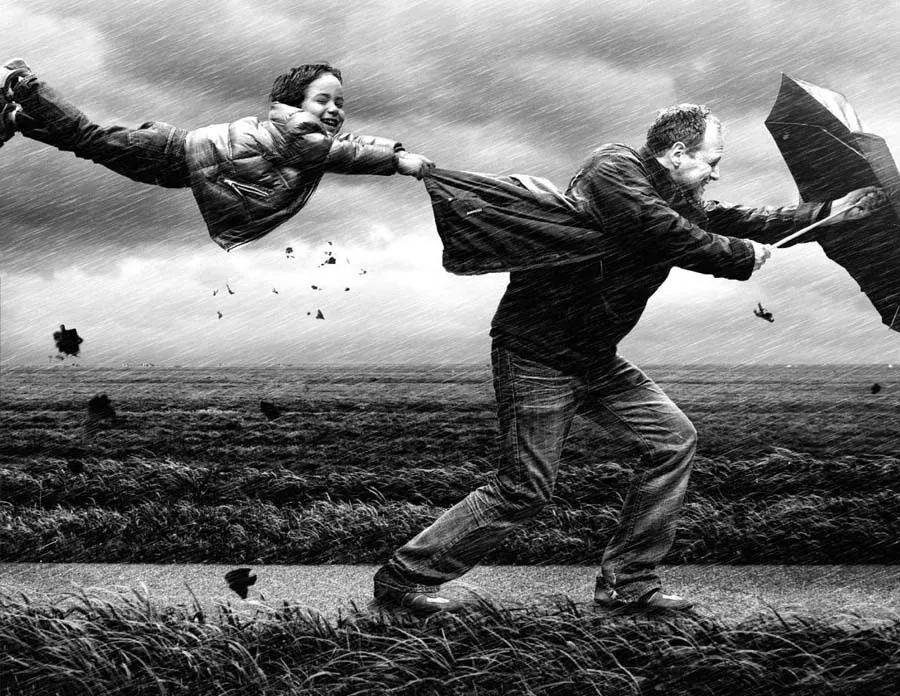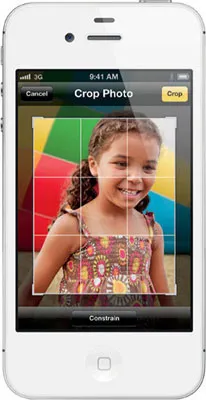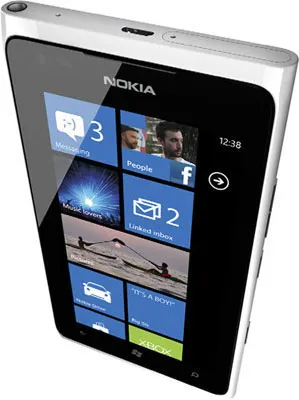![]()
CHAPTER 1
GETTING STARTED
Wind by Adrian Sommeling
The first step in the creation of any surreal image will be a clear concept of the vision that you’re trying to create. After you have this, you’ll need to either take or source your base images to adapt, manipulate, and composite.
If you’re taking your base images yourself, it’s very easy to feel the need to keep up with the market when it comes to cameras. The speed at which photographic technology is evolving is mind-bending, but always remember that the most important element in the creation of a good photograph is the photographer—and her or his skill and vision—and not the camera. This is why I’ve included this chapter on cameras, to show you that any type of camera will be sufficient, whether it is a flagship DSLR, a film camera, a point and shoot, or even a cellphone.
A concept of the surreal
It might help to think of the process of creating a surreal image as a recipe: here is what you want to create, these are the things that you will need to achieve it, and these are the steps you will need to take in the process.
I first fell in love with photography because it allowed me the opportunity to show people how I saw the world. Whether they shared my vision wasn’t so much the point; what I loved was the chance to communicate it. Surreal photography is, perhaps, all the more exciting because it fuses the world around you—something that other people are able to experience, even if they don’t see it the same way as you do—with something that is entirely unique to you: your subconscious, your dreams, and your imagination. What you experience as surreal, then, might be entirely contrary to someone else’s concept of the surreal.
This book explores two different methods of creating surreal images: with your camera, and with digital manipulation. In some respects, using your camera alone to create surreal images might owe a little to chance—you can’t tell exactly how a cross-processed image will look until the film is developed, for example. With other techniques, it will take practice to become entirely familiar with the effects of a fisheye lens or an IR filter so that you can shoot to achieve the outcome that you want. The more you practise these things, the more intuitive they will become. Not only that, but the more that you immerse yourself in the world of the surreal, the more ideas you will want to explore and develop.
Notebook by Daniela Bowker
When you use digital manipulation to create a surreal image, you might have taken a photograph that you feel can be altered to express a surreal vision, or you might have a surreal vision that you wish to create before you have any images. If you want to recreate your surreal vision from scratch, it’s probably best to treat it as a project: map out what it is that you want to create, plan what you will need, how you will go about sourcing it, account for every item in the image and every step in the process, and cover every eventuality. If it sounds a long way from spontaneous creativity, that’s because it is, but you don’t want to be compositing your final image to find that you didn’t shoot Little Red Riding Hood in her pristine red cloak, just her torn and muddied one, when actually you need both images.
Finally, don’t think that surreal photography has to be one thing or the other, physical or digital. It doesn’t mean you need to use an IR filter in isolation from the host of tools in your editing suite, or cross-process without the option to composite. The more that you explore all the options available to you to create surreal images, the more you will end up learning about how they can work in conjunction with each other, and the deeper your journey into surreal photography will be.
A Good Recipe
Creating a surreal image is a little like baking: you need a recipe to make a good cake.
Shoot stats:
Canon EOS Rebel XSi with a Canon EF 50mm ƒ/1.8 II lens at 50mm; ƒ/1.8 with a shuttter speed of 1/3200 second and ISO 200.
Cameraphones & compact cameras
While I don’t go everywhere with my DSLR, the chances of me being caught without a camera are almost nil. I usually have a smartphone in my pocket and a compact camera in my bag, both of which are important components of my photo-taking arsenal and more than capable of producing images worthy of a little surreal transformation.
iPhone 5
With its combination of a good camera and huge range of compatible editing apps, the iPhone has proved to be a photographic game-changer. The widespread use of the term “iPhoneography,” a variant of the broader “phoneography” points to its common popularity.
Samsung Galaxy S III
The continued improvement of cameras in cellphones is leading people to question the usefulness of the compact camera.
Nokia Lumia 900
The camera in this phone has an aperture of ƒ/2.2 and a resolution of 8 megapixels. It can definitely be used to make quality surreal images.
CAMERAPHONES
Cameras have been a ubiquitous component of the cellphone for years now; there are some phones that come without the ability to snap a quick picture, but you almost have to go out of your way to find one. Just as the technology in compact cameras and DSLRs has progressed, so too have the cameras in phones. The iPhone 5, the Nokia Lumia 900, and Samsung’s Galaxy S III all come with 8-megapixel sensors, something you would have been hard-pressed to find in a flagship DSLR a decade ago. Their lenses offer apertures of ƒ/2.4, ƒ/2.2, and ƒ/2.6 respectively—impressive, as some current compact cameras don’t have lenses that fast. The improvements are only going to continue, but as of right now you can create perfectly acceptable surreal images with a good phone.
When it comes to creating surreal images from photos taken on a cellphone, the smartphone has the advantage over any other. For a start, it is generally easier to access the images taken on a smartphone—you can email them to yourself or save them to the Cloud—and the cameras in smartphones tend to be of superior quality. However, the killer feature of the smartphone is that you don’t have to transfer the photo anywhere else in order to give it a surreal makeover. By virtue of any one of hundreds of applications (or apps) that are available for download, some for free and some at a small cost, you can transform an ordinary shot into something out of this world. We’ll look at the best apps and what you can achieve with them in Chapter Two: Phoneography & Compact Cameras.
If you’re a little apprehensive of using a smartphone to grab a potential surreal shot, don’t be. It’s a lens with a shutter and a sensor—you can work one of those! There are a few things you can do to help your phoneography on its way to surreal awesomeness, though.
First, make sure that your subject is well-lit. Cameraphones have small sensors, which can result in noisy, grainy images if they’re taken in low-light situations. A lot of light will make all the difference.
Second, get in close, but avoid using the digital zoom function. You want your subject to fill the frame so that you don’t have to crop it later and sacrifice image quality. The digital zoom will do terrible things to your image quality, so it’s best left alone.
Third, keep still! This goes for any photography, but is especially important when using a phone because the small size accentuates camera shake. If you can, lean or rest your camera on something, hold your breath when you release the shutter, and remember that shutter lag might mean that your image isn’t actually captured for a few moments after you’ve released the shutter.
Finally, give your lens a quick clean before you take a photo. Your phone lives in your pocket or your bag and spends ...





